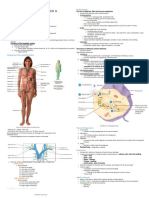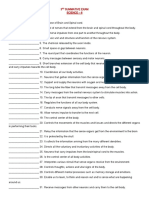Restorative Dentistry
Restorative Dentistry
Uploaded by
junquelalaCopyright:
Available Formats
Restorative Dentistry
Restorative Dentistry
Uploaded by
junquelalaOriginal Description:
Copyright
Available Formats
Share this document
Did you find this document useful?
Is this content inappropriate?
Copyright:
Available Formats
Restorative Dentistry
Restorative Dentistry
Uploaded by
junquelalaCopyright:
Available Formats
Cracked tooth- filling or implant
RESTORATIVE DENTISTRY • can result from chewing on hard foods, grinding your teeth at night, and may also
Friday, February 19, 2021 11:53 AM occur spontaneously as you age. It is a common disorder and the primary cause of
tooth loss.
18th century
• Field of operative dentistry embraced all of chairside and it was performed by barbers Treatment depends on the size of the crack, where it is located, the complications, and
19th century whether the crack reaches to the gum line. Based on these factors, your dentist can
• dentistry was practiced professionally by dentists or surgeons. prescribe one of the following:
1. 1.Bonding
20th century ▪ In this method, the dentist will use plastic resin to fill the gap, restore its
• came improvements in the quality of various materials and processes in dentistry. appearance and function.
• Physical and mechanical tests combined with fundamentals of engineering science were 2. Crowns
applied in design of operative dentistry and other branches have shown with different ▪ A dental crown is a tooth shaped cap that is placed over a tooth, it fits over
specialists and operative dentistry was focused more on restoration that makes operative the damaged tooth or caps it.
dentistry named as Restorative dentistry. ▪ It is the best treatment to restore its shape, size, strength, and appearance.
3. Implant
Operative dentistry is defined as the science and art of dentistry which deals with diagnosis, ▪ If a cracked tooth is severely damaged and couldn’t be saved by the
treatment, and prognosis of defects of the teeth which do not require full coverage for dentist. Patients can also opt for an implant, or extraction alone.
correction.
Implant has many advantages:
The main purposes of Restorative Dentistry are: □ Designed to be permanent
1. Diagnosis □ Preserves bone
2. Prevention □ Does not damage adjacent teeth
3. Interception □ Look and feel like natural tooth
4. Maintenance □ Improves appearance and self esteem
Treatment: caries removal and filling
Dr. Greene Vardiman Black is one of the founders of modern dentistry and is known to be the Reversible pulpitis refers to instances where the inflammation is mild and the
“Father of Operative Dentistry”. tooth pulp remains healthy enough to save.
For the treatment, caries removal and filling are needed. If you have reversible
Armamentaria pulpitis, treating the cause of the inflammation should resolve your symptoms.
• Amalgam Carrier – used to carry an increment of amalgam directly into the prepared Removing the decay and placing a filling allows the pulp to recover and
tooth. eliminates any further discomfort.
• Burnisher – used to smooth the surface of a freshly placed amalgam restoration.
• Condensers – used to pack down freshly placed amalgam into the preparation. Tooth enamel erosion - bridges, bonding, or crowns
• Composite Placement Instrument – used for the placement of composite restorative
materials. • Tooth enamel is the thin outer covering of the tooth and is considered as the strongest
• Carvers – used to remove excess material, to contour surfaces, and to carve anatomy substance in your body – even tougher than bone. This helps protect the teeth against
back into the amalgam. many different chemicals they’re exposed to but in spite of its strength, everyday acids
• Woodson – used for carrying dental materials to the prepared tooth structure. that develop from certain foods and drinks can put your enamel at risk. Consequently,
it can be prone to wear and tear which is now referred to as enamel erosion.
Disease and Treatments
Dental caries - filling, crown or RCT Common signs and symptoms of dental erosion include tooth sensitivity which causes the
• known as tooth decay, is a chronic condition commonly occurring to children, adolescents, tooth to be more sensitive to heat and cold, tooth discoloration, tooth breakdown and
and even adults due to the breakdown of the tooth enamel caused by the acids produced transparency of the edges of the front teeth. The most common cause of enamel erosion is
by bacterias that breakdown foods. the over abandoned of acids inside the mouth. It can be introduced externally by drinking
acidic beverages such as soda and fruit juice and it can also be introduced internally by
Treatments: medical conditions that introduce stomach acids into the mouth such as acid reflux nor
bulimia.
a. Fillings - applied when the tooth decay cannot be treated by the most basic
treatment which is fluoride use, the decayed tooth is filled with dental amalgam,
If the enamel loss is significant, the dentist may recommend the following.
porcelain, or tooth-colored composite resins
b. Crowns - applied to extensively decayed tooth wherein all the decayed surface of the Treatment:
tooth is drilled and remove then replaced by a custom-fitted crown that succeeds the
entire natural crown of the tooth
c. Root canal therapy - applied when the decay reached the pulp of the tooth, the pulp 1. Bonding- if enamel erosion has caused discolorations on your front teeth, bonding is a
is removed and replaced by a filling which sometimes requires medication to clear procedure in which a tooth-colored material known as resin is applied to stained or
any infections damaged teeth. The resin can cover up discolorations and protect your tooth.
2. Bridges- This has four main types such as traditional, cantilever, Maryland, and
implant-supported. This treatment is applied when the enamel is overly damaged, it
Tooth extraction is the last resort if the tooth is severely decayed and cannot be
could restore the look of your smile by replacing the missing tooth or "bridges" the gap
restored. The gaps left by the extracted tooth can still be replaced by dental bridges
where there are missing teeth with one that can look as natural as the original.
or dental implants.
3. Crowns- this is applied when the teeth is extremely damaged nor fractured or even
suffered decay to the point where a filling cannot repair it, crowns improves the
appearance of a misshapen or discolored tooth.
PRSPRCT1 Page 1
You might also like
- German Men Sit Down To Pee and Other Insights Into German Culture - MR Niklas Frank - MR James CaveDocument141 pagesGerman Men Sit Down To Pee and Other Insights Into German Culture - MR Niklas Frank - MR James Cavetothestars0002No ratings yet
- Space Maintainer - A ReviewDocument5 pagesSpace Maintainer - A ReviewHabeeb AL-Absi100% (1)
- JHA HousekeepingDocument3 pagesJHA HousekeepingFatin ZawawiNo ratings yet
- End of Term Exam Dec 2019 p1Document11 pagesEnd of Term Exam Dec 2019 p1Mustafa100% (1)
- Cavity Designs For Composite RestorationsDocument20 pagesCavity Designs For Composite RestorationsAditi Chandra0% (5)
- Laminates and VennersDocument42 pagesLaminates and VennersJASPREETKAUR0410100% (1)
- Denture Trouble Shooting GuideDocument5 pagesDenture Trouble Shooting Guideairtifa1No ratings yet
- Interproximal ReductionDocument7 pagesInterproximal ReductionsaiyangokuusaNo ratings yet
- CD ReviewerDocument12 pagesCD Reviewerjznddthr2jNo ratings yet
- Inlay OnlayDocument6 pagesInlay OnlayNur HayatiNo ratings yet
- Improving Your Smile With Dental VeneersDocument1 pageImproving Your Smile With Dental VeneersheycoolalexNo ratings yet
- Introduction To Dental MaterialsDocument4 pagesIntroduction To Dental MaterialsJEANASHLEY PUNZALANNo ratings yet
- Dental Materials - PrelimsDocument39 pagesDental Materials - PrelimsJEANASHLEY PUNZALAN100% (1)
- Restorative Tooth AestheticsDocument14 pagesRestorative Tooth AestheticsTerry BatoyogNo ratings yet
- KHBFDocument58 pagesKHBFgitaNo ratings yet
- CD&endoDocument24 pagesCD&endoSini SajeevNo ratings yet
- Ce333 - 3 31 21Document11 pagesCe333 - 3 31 21Tuan NguyenNo ratings yet
- BOS - Counselling DocumentsDocument104 pagesBOS - Counselling DocumentsUmair Wali KhanNo ratings yet
- (Kelompok B) Jurnal 1 AsliDocument4 pages(Kelompok B) Jurnal 1 AsliAstrid GanadyaNo ratings yet
- Ceramic Veneers in General Dental PracticeDocument11 pagesCeramic Veneers in General Dental PracticeheycoolalexNo ratings yet
- JInterdiscipDentistry3112-5456729 150927Document6 pagesJInterdiscipDentistry3112-5456729 150927Nisha GargNo ratings yet
- 1 - Indications For Removal of TeethDocument7 pages1 - Indications For Removal of TeethLama NahedNo ratings yet
- Restorative DentistryDocument32 pagesRestorative DentistryĐỗ Thành KhangNo ratings yet
- Prevention of Traumatic Dental Injuries-1Document32 pagesPrevention of Traumatic Dental Injuries-1saher2010100% (1)
- Restorative Onlay and Inlay Its Classifications (Different Types), Indications, and AdvantagesDocument14 pagesRestorative Onlay and Inlay Its Classifications (Different Types), Indications, and AdvantagesJALEN DAVE BINUCASNo ratings yet
- Single DentureDocument18 pagesSingle DentureKamugisha MosesNo ratings yet
- Overdenture Attachment 1Document7 pagesOverdenture Attachment 1Dr Tarak ChavadaNo ratings yet
- Young Dentist August13Document3 pagesYoung Dentist August13RusevNo ratings yet
- Denu 2010 37 2 82Document7 pagesDenu 2010 37 2 82Daniel AtiehNo ratings yet
- 11 VennersDocument119 pages11 VennersHarmit ShuklaNo ratings yet
- How To Fix Gap TeethDocument9 pagesHow To Fix Gap TeethTrent SinanNo ratings yet
- Tooth-Supported Overdentures 2 PDFDocument7 pagesTooth-Supported Overdentures 2 PDFKrupali JainNo ratings yet
- Porcelain Laminate VeneersDocument38 pagesPorcelain Laminate VeneersShipra SinghalNo ratings yet
- Review of DiagnosisDocument4 pagesReview of DiagnosisKriznilyn SibugNo ratings yet
- Overdenture: DR Balendra Pratap Singh Assistant Professor Department of ProsthodonticsDocument51 pagesOverdenture: DR Balendra Pratap Singh Assistant Professor Department of Prosthodonticssneha palNo ratings yet
- 020 Over DenturesDocument60 pages020 Over DenturesKhan MustafaNo ratings yet
- 020 Over Dentures.Document60 pages020 Over Dentures.Khan MustafaNo ratings yet
- Over Dentures (Prostho)Document34 pagesOver Dentures (Prostho)FourthMolar.comNo ratings yet
- Dr. Femina Subair: About MeDocument1 pageDr. Femina Subair: About Mefemina subairNo ratings yet
- Pediatric Preformed Metal Crowns - An Update Indi KontraDocument4 pagesPediatric Preformed Metal Crowns - An Update Indi KontralulukzNo ratings yet
- Chapter 15Document63 pagesChapter 15Christine Alliana LitonjuaNo ratings yet
- Presentation 2 Phase Treatment-2Document13 pagesPresentation 2 Phase Treatment-2memotarek2066No ratings yet
- Bleaching Part 1Document6 pagesBleaching Part 1Hamad KayaniNo ratings yet
- Teeth Root Canal TreatmentDocument3 pagesTeeth Root Canal TreatmentAdit Wendy YRNo ratings yet
- 2.veneers and Laminates: 1. LumineersDocument4 pages2.veneers and Laminates: 1. Lumineerssfhussain8No ratings yet
- Tooth Extraction Bahasa InggrisDocument3 pagesTooth Extraction Bahasa InggrisNoviyana Idrus DgmapatoNo ratings yet
- Sample NOT FOR Reproduction: Interproximal ReductionDocument2 pagesSample NOT FOR Reproduction: Interproximal ReductionhemaadriNo ratings yet
- Artículo 4Document5 pagesArtículo 4Maria Camila Tejada FigueroaNo ratings yet
- Int J Paed Dentistry - 2001Document5 pagesInt J Paed Dentistry - 2001Dina ElkharadlyNo ratings yet
- Christensen 1999Document2 pagesChristensen 1999Natalia LedezmaNo ratings yet
- Has Tooth Structure Been Replaced?: ObservationsDocument3 pagesHas Tooth Structure Been Replaced?: Observationsmedodido94No ratings yet
- Crown LengthingDocument12 pagesCrown LengthingMohamed Khalil Khalil Ahmed Ellabban Ahmed EllabbanNo ratings yet
- VeneerDocument48 pagesVeneerAli IhsanNo ratings yet
- Laminates AND Veneers: Dr. Sakshi Rawal Department of Prosthodontics MDS II YearDocument76 pagesLaminates AND Veneers: Dr. Sakshi Rawal Department of Prosthodontics MDS II Yearsapna100% (2)
- RCT AdviceDocument4 pagesRCT AdviceMohammed NabeelNo ratings yet
- AGD FactSheet ErosionDocument1 pageAGD FactSheet ErosionLira May LachicaNo ratings yet
- Esthetic Crowns For Primary Teeth A Review PDFDocument7 pagesEsthetic Crowns For Primary Teeth A Review PDFSan SanNo ratings yet
- Regressive Alteration of TeethDocument29 pagesRegressive Alteration of TeethLavanya Kalapala100% (3)
- Direct CompositDocument8 pagesDirect CompositJulianna BartalusNo ratings yet
- Dental Crowns.Document6 pagesDental Crowns.DUKE100% (1)
- Management of AvulsedDocument7 pagesManagement of AvulsedDr.O.R.GANESAMURTHI100% (1)
- Challenges in Dentin BondingDocument11 pagesChallenges in Dentin BondingDanish Sattar100% (1)
- How to Heal Teeth Naturally & Cure Tooth Decay: The book on holistic dental care, healing cavities, toothaches, dental pains, oil pulling and more...From EverandHow to Heal Teeth Naturally & Cure Tooth Decay: The book on holistic dental care, healing cavities, toothaches, dental pains, oil pulling and more...Rating: 3.5 out of 5 stars3.5/5 (9)
- Oral Prophylaxis: Prophylaxis Remove Dental Plaque and Other IrritantsDocument3 pagesOral Prophylaxis: Prophylaxis Remove Dental Plaque and Other IrritantsjunquelalaNo ratings yet
- Oral Surgery: Incise ExciseDocument2 pagesOral Surgery: Incise ExcisejunquelalaNo ratings yet
- Module 9: Lymphatic System & Immunity: InnateDocument5 pagesModule 9: Lymphatic System & Immunity: InnatejunquelalaNo ratings yet
- Module 10: Respiratory: Increasing Size of LungsDocument5 pagesModule 10: Respiratory: Increasing Size of LungsjunquelalaNo ratings yet
- MakadiyosDocument9 pagesMakadiyosjunquelalaNo ratings yet
- Oral Hygiene Toothbrush One Cycle Per SecondDocument3 pagesOral Hygiene Toothbrush One Cycle Per SecondjunquelalaNo ratings yet
- PedodonticsDocument2 pagesPedodonticsjunquelalaNo ratings yet
- 9 Things We Loved About Food in The Past DecadeDocument23 pages9 Things We Loved About Food in The Past DecadejunquelalaNo ratings yet
- Hand Instruments: Thursday, March 18, 2021 02:23 PMDocument2 pagesHand Instruments: Thursday, March 18, 2021 02:23 PMjunquelala100% (1)
- NSTP Group 3: Republic Act 9163Document9 pagesNSTP Group 3: Republic Act 9163junquelalaNo ratings yet
- History: Sunday, August 16, 2020 10:22 AMDocument2 pagesHistory: Sunday, August 16, 2020 10:22 AMjunquelalaNo ratings yet
- What Is Art: Introduction and AssumptionsDocument7 pagesWhat Is Art: Introduction and AssumptionsjunquelalaNo ratings yet
- Traditional Dance (Folk and Ethnic)Document5 pagesTraditional Dance (Folk and Ethnic)junquelala100% (3)
- EstersDocument3 pagesEstersjunquelalaNo ratings yet
- Ballroom Dances HANDOUTSDocument3 pagesBallroom Dances HANDOUTSjunquelalaNo ratings yet
- Pearsons RDocument8 pagesPearsons RjunquelalaNo ratings yet
- Prepared By: Sheryl D. Galecia: Art Appreciation Handout Philosophical Perspectives On ArtDocument2 pagesPrepared By: Sheryl D. Galecia: Art Appreciation Handout Philosophical Perspectives On ArtjunquelalaNo ratings yet
- Art and Artisans Production Process, Medium, TechniqueDocument5 pagesArt and Artisans Production Process, Medium, Techniquejunquelala100% (1)
- Jean-Paul Sartre (French Philosopher in The 20 Century) : Art As ExpressionDocument6 pagesJean-Paul Sartre (French Philosopher in The 20 Century) : Art As ExpressionjunquelalaNo ratings yet
- Work Energy and PowerDocument5 pagesWork Energy and PowerjunquelalaNo ratings yet
- Fluid MechanicsDocument2 pagesFluid MechanicsjunquelalaNo ratings yet
- GBII - Phylum Annelida - Platyhelminthes.molluskaDocument9 pagesGBII - Phylum Annelida - Platyhelminthes.molluskajunquelalaNo ratings yet
- X V Principal SecretaryDocument6 pagesX V Principal SecretaryAniket MishraNo ratings yet
- Cordewener 2017Document7 pagesCordewener 2017patricia brucellariaNo ratings yet
- PRBSEC-47 Internal Examination FormDocument2 pagesPRBSEC-47 Internal Examination FormRaven OrlinoNo ratings yet
- 3RD Summative Exam in Science 6Document6 pages3RD Summative Exam in Science 6Maricris Palermo Sancio100% (1)
- Outcomes-Based Teaching and Learning Plan (OBTL) : Tagoloan Community CollegeDocument8 pagesOutcomes-Based Teaching and Learning Plan (OBTL) : Tagoloan Community CollegeJimbo J. AntipoloNo ratings yet
- Healthcare Providers in Nigeria March 2022: Marketline Industry ProfileDocument40 pagesHealthcare Providers in Nigeria March 2022: Marketline Industry ProfileOluwaloni MatthewNo ratings yet
- Format Lplpo Pustu 2023Document5 pagesFormat Lplpo Pustu 2023Ami SangajiNo ratings yet
- VKC CertificateDocument1 pageVKC CertificateDigital Seva KendraNo ratings yet
- Chapter 2 .Document29 pagesChapter 2 .Sulaiman Al-qarawnehNo ratings yet
- The Social Context of Dental EstheticsDocument2 pagesThe Social Context of Dental EstheticsLester MoeNo ratings yet
- Digital Detox MDocument2 pagesDigital Detox MGaluhNo ratings yet
- (FREE COPY) HSE Auditor Resume SampleDocument2 pages(FREE COPY) HSE Auditor Resume SamplerishibarathiNo ratings yet
- Sas#4-Ped 027Document9 pagesSas#4-Ped 027erica lamsenNo ratings yet
- Using Master Tung's Gallbladder Points For Diseases of The Head and NeckDocument2 pagesUsing Master Tung's Gallbladder Points For Diseases of The Head and NeckTrần Hồ Thạnh Phú100% (2)
- Sun 2013Document7 pagesSun 2013Sirine LimemeNo ratings yet
- A Christmas Carol A03 Context QuotesDocument4 pagesA Christmas Carol A03 Context QuotesuzzzNo ratings yet
- Work Permit ApplicationDocument23 pagesWork Permit ApplicationAdrianNo ratings yet
- notesTHEORETICAL FOUNDATION OF NURSING2Document5 pagesnotesTHEORETICAL FOUNDATION OF NURSING2janijannahh17No ratings yet
- Review of Related Literature and StudiesDocument10 pagesReview of Related Literature and StudiesPia Loraine BacongNo ratings yet
- Homeward DC Report FY 2021 2025Document61 pagesHomeward DC Report FY 2021 2025MariaNo ratings yet
- Health Insurance Certificate of Continuity - IndividualDocument1 pageHealth Insurance Certificate of Continuity - IndividualAMR ABDALHNo ratings yet
- Week 5 - Informatics Final PaperDocument11 pagesWeek 5 - Informatics Final Paperapi-549106443No ratings yet
- II. Nursing Assessment 1. Personal Data A. Demographic Data NameDocument11 pagesII. Nursing Assessment 1. Personal Data A. Demographic Data Namejayanine20100% (6)
- m1 Nadi ShodhanDocument4 pagesm1 Nadi ShodhanBruna JustenNo ratings yet
- BC-6000 Series Service Manual - V16.0Document374 pagesBC-6000 Series Service Manual - V16.0FERMIN TAFUR LLIUYANo ratings yet
- NCP Impaired Cerebral Tissue PerfussionDocument4 pagesNCP Impaired Cerebral Tissue PerfussionYvonne Ronamae100% (2)















































































































